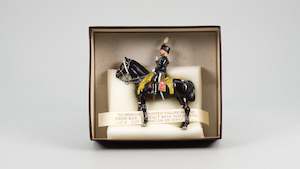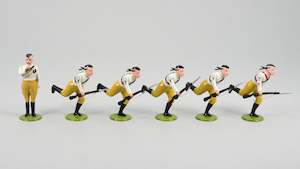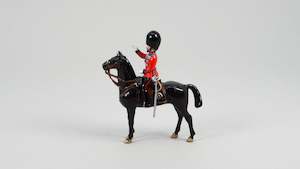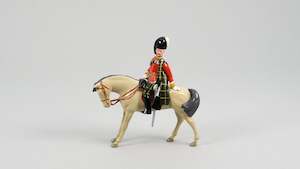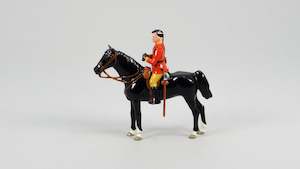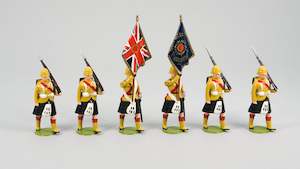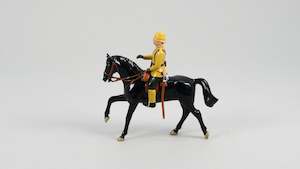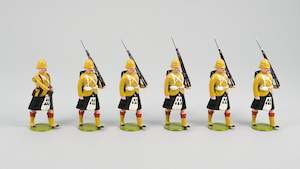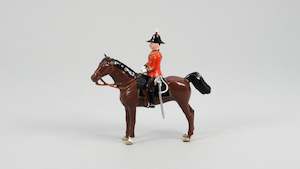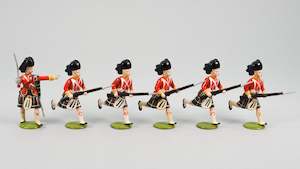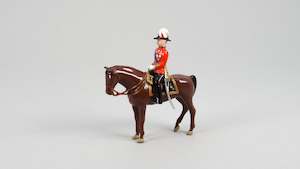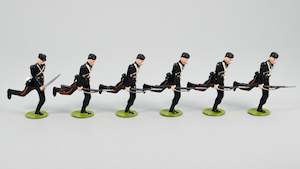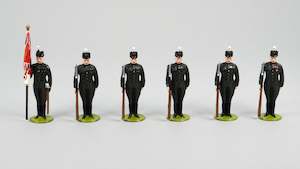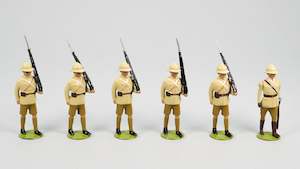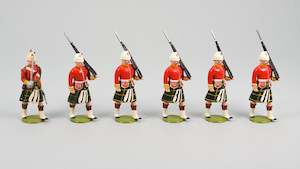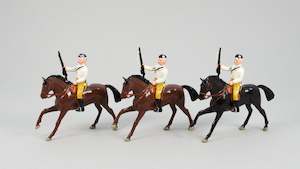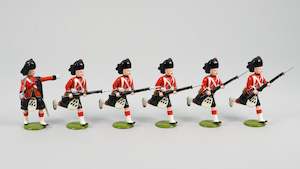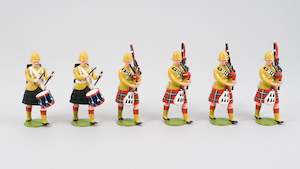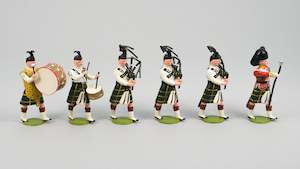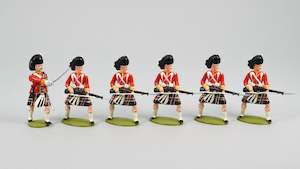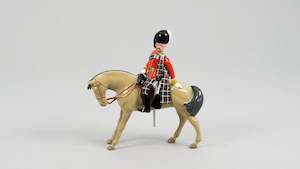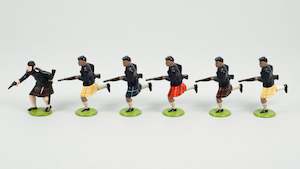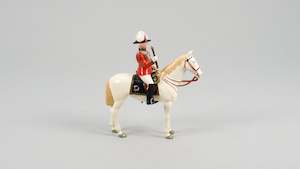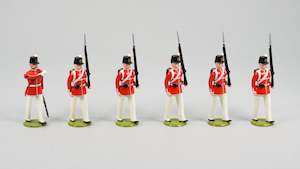Imperial Productions 1 views Claim this Business♡
×-
16 Highland Mounted Infantry, 1896In 1875 the British Army recognised the need for Mounted Infantry detachments. The first ‘School of Instruction’ was established at Aldershot, and training was in progress by 1888.In 1896 the Highland Company of Mounted Infantry composed of detachments drawn from The Black Watch, The Seaforth Hi...Visit Store ⊕ More like this 0 0
-
24 Colour Party, Black Watch 1900, Foreign Service DressThe 2nd Battalion of the Black Watch arrived in South Africa on 14th November 1899. With the brigade commanded by Major General Andrew Wauchope they advanced against the Boers, well positioned on the 200-foot high Magersfontein Ridge. Not a man reached the ridge and Wauchope was among the swathes of...Visit Store ⊕ More like this 0 0
-
26 Officer, Black Watch, 1900, Foreign Service DressThe 2nd Battalion of the Black Watch arrived in South Africa on 14th November 1899. With the brigade commanded by Major General Andrew Wauchope they advanced against the Boers, well positioned on the 200-foot high Magersfontein Ridge. Not a man reached the ridge and Wauchope was among the swathes of...Visit Store ⊕ More like this 0 0
-
23 Black Watch, 1900, Foreign Service DressThe 2nd Battalion of the Black Watch arrived in South Africa on 14th November 1899. With the brigade commanded by Major General Andrew Wauchope they advanced against the Boers, well positioned on the 200-foot high Magersfontein Ridge. Not a man reached the ridge and Wauchope was among the swathes of...Visit Store ⊕ More like this 0 0
-
13c Seaforths Charging, 1895The 42nd Regiment was raised in 1739 as the 43rd. In 1749 it became the 42nd. It received the title of ‘Royal Highland Regiment’ in 1758 and in 1795 was permitted to wear a red feather as a special distinction.The 73rd Regiment was raised in 1781 as the 2nd Battalion of the 42nd. It was numbered...Visit Store ⊕ More like this 0 0
-
2 Waikato Militia, 1864Many of the regiments four thousand recruits were from Australia, where the regiment was raised in 1863. In October 1864 they were in action at Titi Hill and in April at Waihi.On 21 June at Pukehinahina and Te Ranga they became the first colonial troops to take part in a charge with British Regulars.Visit Store ⊕ More like this 0 0
-
8 Eketahuna Mounted Rifles, 1907The Ekatahuna Mounted Rifles were accepted as a Volunteer Corps on 10 September 1900, but not before some men had already left to serve in the South African War.Dress uniforms were provided in 1904, and their colour was presented in 1907 by the Governor, Lord Plunket, on New Zealand’s first Dominion Day.Visit Store ⊕ More like this 0 0
-
5 Maori Contingent, 1914In the first year of the war in 1914, two Maori companies were formed. This contingent left New Zealand for Egypt in February 1915, and from July 1915 took part in the Gallipoli Campaign.After this campaign the Contingent was split up, but after Maori protest at home the unit was reformed as a Pioneer Battalion and served in France.Visit Store ⊕ More like this 0 0
-
7 South Australian Scottish Infantry, 1903After a meeting in early 1900, “G" Company, 2nd Battalion (Reserve) Adelaide Rifles, was formed. Their first kilted parade was Queen Victoria’s memorial service at Flinders Street Presbyterian Church.In 1903 “G" Company became the South Australian Scottish Infantry. They last paraded in 1912. Several members of the unit later commanded Infantry Battalions in World War I.Visit Store ⊕ More like this 0 0
-
17 Highland Mounted Infantry, 1896In 1875 the British Army recognised the need for Mounted Infantry detachments. The first ‘School of Instruction’ was established at Aldershot, and training was in progress by 1888.In 1896 the Highland Company of Mounted Infantry composed of detachments drawn from The Black Watch, The Seaforth Hi...Visit Store ⊕ More like this 0 0
-
13a Black Watch Charging, 1895The Black Watch, Royal Highland Regiment.The 42nd Regiment was raised in 1739 as the 43rd. In 1749 it became the 42nd. It received the title of ‘Royal Highland Regiment’ in 1758 and in 1795 was permitted to wear a red feather as a special distinction.The 73rd Regiment was raised in 1781 as the 2...Visit Store ⊕ More like this 0 0
-
25b Pipes and drums of the Black Watch, 1900, Foreign Service Dress add-on set to No.25aThe 2nd Battalion of the Black Watch arrived in South Africa on 14th November 1899. With the brigade commanded by Major General Andrew Wauchope they advanced against the Boers, well positioned on the 200-foot high Magersfontein Ridge. Not a man reached the ridge and Wauchope was among the swathes of...Visit Store ⊕ More like this 0 0
-
10a Pipes and drums of the South Australian Scottish Infantry, 1903After a meeting in early 1900, "G" Company, 2nd Battalion (Reserve) Adelaide Rifles, was formed. Their first kilted parade was Queen Victoria's memorial service at Flinders Street Presbyterian Church. In 1903 "G" Company became the South Australian Scottish Infantry. They last paraded in 1912. Several members of the unit later commanded Infantry Battalions in World War I.Visit Store ⊕ More like this 0 0
-
12c Seaforth Highlanders at the ReadyUntil their amalgamation in the above Regiment in 1881 the 1st and 2nd Battalions were respectively the 72nd and 78th Regiments of Foot. The 72nd Regiment was raised by the Earl of Seaforth in 1777. In 1823, as a special mark of Royal favour it received the title of ‘The Duke of Albany’s Own Hig...Visit Store ⊕ More like this 0 0
-
11 Capt. Gilbert Mair and the No. 1 Arawa Flying ColumnGilbert Mair’s seafaring father settled in the Bay of Islands, North Auckland in 1824. In 1827 he married Elizabeth Puckey and later gave up sailing to establish a trading post at Te Wahapu, near Kororareka. In 1842 with Hone Heke threatening war the family moved to a farm south of Whangarei, wher...Visit Store ⊕ More like this 0 0
-
14 65th Regiment of Foot, 1863Of all the Imperial Regiments that were stationed in New Zealand last century, none had a finer record or served longer than the 65th (Yorkshire North Riding) Regiment of Foot.Arriving in New Zealand from Australia in 1846, it was soon active in the Wellington and Wanganui skirmishes of 1846-47. The...Visit Store ⊕ More like this 0 0
×

